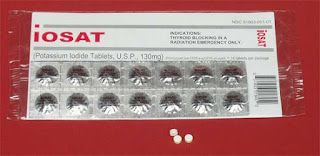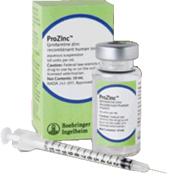We submitted a complete blood count, serum chemistry panel, complete urinalysis, and urine culture to the lab that day, which showed the following abnormalities:
Serum Chemistry Panel:
- Alkaline phosphatase: 1061 IU/L (reference range, 5-131)
- GGT: 18 IU/L (reference range, 1-12)
- Glucose: 649 mg/dl (reference range, 70-138)
- Triglyceride 414 mg/dL (reference range, 29-291)
- Specific gravity: 1.029
- Glucosuria: 3+
- Ketones: Negative
- Urine culture:
- negative
We did an serial blood glucose cure 2 weeks later. Results showed marked and persistant hyperglycemia (> 400 mg/dl) throughout the day. Based upon the glucose curve, we diagnosed insulin resistance and did a low-dose dexamethasone response test. Results of that test were positive, and indicate pituitary-dependent Cushing's disease (see below):
- Basal cortisol: 5.8 μg/dl (reference range, 1.0-5.0 μg/dl)
- 4-hr post-cortisol: 0.9 μg/dl (reference range, <1.4 μg/dl)
- 8-hr post-cortisol: 5.7 μg/dl (reference range, <1.4 μg/dl)
My Response:
The problem with diabetic dogs is that it's very difficult to make a diagnosis of Cushing's with certainty unless we see cutaneous changes. PU/PD, polyphagia, and high liver values all could be secondary to the diabetes. False-positive test results on a LDDST are very common in dogs with nonadrenal illness, such as diabetes (1-3).
Does he have any cutaneous signs (hair loss, etc)? His insulin dose isn't high enough to say that he has insulin resistance. I'd recommend that you continue to monitor Rex closely an slowly raise his NPH dose to see if that helps control his signs. Because it can be very difficult to be sure in these diabetic dogs, sometimes observation and monitoring is the best course.
Follow-up:
Rex's coat looks pretty normal right now. We'll try raising his insulin dose before assuming that Cushing's disease is his underlying problem. Two more questions:
- At what insulin dose do we get concerned about resistance?
- Could diabetes explain the pot belly and marked hepatomegaly?
We define insulin resistance as doses greater than 2.2 U/kg/injection to control hyperglycemia (4), so we aren't even close to the doses required to diagnose resistance.
And yes, diabetic dogs can get marked hepatomegaly secondary to fat accumulation in the liver. That can lead to a mild-moderate "pot bellied" appearance.
Because it can be very difficult to make a diagnosis of Cushing's syndrome in dogs with diabetes, observation and monitoring is the best course in many of these patients. If Cushing's disease is present, it will be progressive and other signs will develop to make the diagnosis easier to confirm.
References:
- Kaplan AJ, Peterson ME, Kemppainen RJ. Effects of disease on the results of diagnostic tests for use in detecting hyperadrenocorticism in dogs. Journal of the American Veterinary Medical Association 1995;207:445-451.
- Kaplan A, Peterson ME. Effects of nonadrenal disease on adrenal function tests In: Bonagura JD (ed): Current Veterinary Therapy XIII. Philadelphia, WB Saunders Co., 2000; pp 362-363.
- Melián C, M. Pérez-Alenza, D, Peterson ME. Hyperadrenocorticism in dogs, In: Ettinger SJ (ed): Textbook of Veterinary Internal Medicine: Diseases of the Dog and Cat (Seventh Edition). Philadelphia, Saunders Elsevier, 2010; pp. 1816-1840.
- Peterson ME. The difficult diabetic: Acromegaly, Cushing’s, and other causes of insulin resistance. North American Veterinary Conference (NAVC) Conference 2012: Small Animal & Exotics Proceedings. pp. 873-879.


























